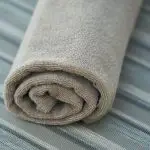When it comes to satin, the desire to shrink it might seem counterintuitive, but there are ways to achieve that if needed.
Understanding the intricacies of satin fabric and its unique response to heat is key. Different types of satin, like cotton, polyester, and silk, require different approaches to prevent unwanted shrinkage.
To explore the methods of safely shrinking satin without compromising its quality, let's uncover some tips and tricks that could help you achieve the desired results effectively.
Table of Contents
Key Takeaways
- Pre-wash satin to remove finishes and oils before shrinking.
- Use proper heat settings and test on scrap fabric.
- Follow a step-by-step guide for gentle shrinking.
- Store shrunken satin in a cool, dry place to maintain its shape.
Preparing Satin for Shrinkage
To get satin ready for shrinking, it's essential to pre-wash the fabric to eliminate any dirt, oils, or finishes that could hinder the shrinking process. This step ensures that the fabric is clean and free from any substances that might interfere with the shrinking of the satin. When preparing satin for intentional shrinkage, it's crucial to carefully check the care label for specific instructions tailored to the fabric type. Different satin fabrics may require varying methods to achieve the desired results without causing damage.
During the preparation phase, it's advisable to avoid exposing the satin to high heat, as this could unintentionally harm the fabric. By following a step-by-step guide or tutorial specific to the type of satin being used, one can ensure the best outcome in terms of achieving the desired shrinkage. Proper preparation sets the foundation for successful shrinking of satin fabric, making it easier to control the process and achieve the intended results effectively.
Understanding Satin Fabric Care
Understanding the care requirements for satin fabric is crucial in maintaining its quality and longevity. Satin fabrics, whether made from silk, wool, cotton, nylon, or polyester, contain delicate fibers that require special attention.
When it comes to washing satin clothes, hand washing is preferred over using a machine to avoid damaging the fabric and causing shrinkage. It's essential to use cold water instead of warm or hot water to preserve the shape of satin garments and prevent them from shrinking.
Dry cleaning is the safest method for handling satin items, especially those labeled as 'dry clean only,' as it helps maintain the fabric's integrity.
Additionally, proper storage in cool, dry places away from heat and light is key to ensuring satin fabrics remain in top condition.
Checking Satin Care Labels
When checking satin care labels, always refer to the specific washing and drying instructions provided. Care labels are essential in maintaining the quality of satin fabrics and preventing shrinkage. They often indicate whether satin should be dry cleaned, hand washed, or machine washed. Following these instructions is crucial to prevent damage to the delicate material.
Pay close attention to details such as water temperature and detergent type recommended on the care label. Using the wrong water temperature can cause satin to shrink, while the improper detergent may harm the fabric. Additionally, the care label may provide guidance on suitable drying methods to preserve the satin's integrity.
Ignoring the care label instructions can result in unwanted shrinkage and damage to your satin garments. By adhering to the washing and drying instructions on the care label, you can help extend the lifespan of your satin items and keep them looking their best.
Removing Stains From Satin
After checking the care labels on your satin items for washing and drying instructions, the next step is effectively removing stains from satin to maintain its pristine appearance. Stains on satin can be quite tricky to deal with due to its delicate nature. Here are some tips to help you tackle stains on your satin pieces:
| Satin Stain Removal Tips | Instructions |
|---|---|
| Mild Detergent Solution | Gently dab the stain with a clean cloth soaked in mild detergent and water. Avoid vigorous rubbing to prevent damage to the delicate satin fibers. |
| Test Cleaning Solution | Before applying any cleaning solution, test it on a small, inconspicuous area of the fabric to ensure it doesn't cause discoloration. |
| Oil-Based Stains | For oil-based stains, sprinkle cornstarch or talcum powder on the stain to absorb excess oil. Gently brush off the powder before treating the stain. |
Shrinking Satin Safely
When it comes to shrinking satin safely, it's crucial to use proper heat settings and avoid high temperatures to prevent damage.
Testing on a scrap piece of satin first can help gauge how the fabric will react to the shrinking process.
Additionally, steering clear of harsh chemicals is essential in maintaining the quality of the satin while shrinking it effectively.
Use Proper Heat
To safely shrink satin, ensure proper heat levels are used to avoid damaging the fabric. Satin can shrink significantly, up to 20%, when exposed to hot water or high heat settings. It's crucial to follow the care label instructions and opt for low heat settings to prevent excessive shrinkage. Hot water washing and high heat drying should be avoided as they can tighten the fibers in satin, leading to unwanted shrinkage.
Test on Scrap Fabric
Before proceeding with shrinking your satin item, it is essential to conduct a test on a small scrap fabric to determine the shrinkage rate accurately. Measure the dimensions of the scrap fabric before and after the shrinking process to adjust your method effectively. Testing on a scrap fabric allows you to prevent damage to your main satin piece by understanding how the fabric responds to the shrinking process. Use the test results to fine-tune your shrinking technique for the best outcome. Below is a table to organize your findings:
| Before Shrinking | After Shrinking | Shrinkage Rate |
|---|---|---|
| 10" x 10" | 9" x 9" | 10% |
| 8" x 8" | 7.2" x 7.2" | 10% |
| 12" x 12" | 10.8" x 10.8" | 10% |
Avoid Harsh Chemicals
How can we ensure the safety of satin while shrinking it without compromising its quality and appearance?
To avoid shrinkage and preserve the beauty of satin, it's crucial to steer clear of harsh chemicals. Opt for gentle detergents that clean satin effectively without causing damage. Harsh chemicals not only strip the fabric of its sheen and softness but also contribute to unwanted shrinkage.
When washing satin, always follow the care label instructions and use mild products to maintain its integrity. Bleach and strong cleaners should be avoided at all costs to prevent shrinkage and keep your satin looking its best. Prioritizing the use of gentle, mild cleaning agents is key to safely shrinking satin while preserving its quality.
Drying Satin for Shrinkage
When drying satin to prevent shrinkage, it's important to consider the fabric type and suitable drying methods.
Polyester satin can shrink on high dryer settings due to the heat exposure, so it's best to avoid the dryer for this fabric.
Silk satin, on the other hand, should never be put in the dryer to prevent shrinkage as the heat can damage the delicate silk fibers.
To avoid shrinkage in satin garments, opt for tumble drying on low heat settings or air drying.
Lay silk satin flat to air dry instead of using the dryer, as this gentle method can help maintain the fabric's quality and prevent any unwanted shrinkage.
Ironing Shrunk Satin
I've found that ironing shrunk satin can be a great way to further decrease its size and reshape the fabric.
Using a low heat setting on the iron is essential to prevent damage to the delicate satin fibers.
Remember to iron the fabric on the reverse side to shield it from direct heat exposure and move the iron gently to evenly distribute heat for optimal shrinking.
Ironing Satin Carefully
When ironing shrunk satin, remember to always use a low heat setting to prevent damage to the delicate fabric. To iron satin carefully, follow these tips:
- Iron the garment inside out to protect the delicate outer surface.
- Move the iron in a gentle, continuous motion to prevent creases or burns.
- Test a small, inconspicuous area first to ensure the satin can withstand the heat.
- Avoid applying direct heat for an extended period to prevent over-shrinking or scorching the fabric.
Using Low Heat
To effectively shrink satin while ironing, ensure you use a low heat setting to gradually reduce the fabric size without causing damage. Start ironing on the reverse side of the satin garment to shield the fabric from direct heat exposure. Move the iron continuously over the satin fabric in a smooth motion to evenly distribute the heat. It's essential to check the fabric periodically while ironing to monitor the progress of the shrinkage. Remember to avoid using steam during this process to maintain control over the heat application. By following these steps, you can successfully shrink your satin fabric without risking any damage.
| Ironing Tips |
|---|
| Use low heat setting |
| Start on the reverse side |
| Move iron continuously |
| Check fabric periodically |
Steam Ironing Technique
Consider using a steam iron on your shrunken satin fabric to effectively tighten the fibers and achieve controlled shrinkage without causing damage. Steam ironing can help shrink satin fabric by applying heat and moisture to tighten the fibers.
Remember to keep the iron on a low heat setting to prevent scorching or melting the satin material. Move the iron in a gentle, consistent motion over the satin fabric to evenly distribute the steam for effective shrinkage. Avoid direct contact between the iron and the satin fabric to prevent potential burns or marks on the material.
Using a steam iron is a great way to achieve the desired shrinkage while maintaining the quality of your satin fabric.
Storing Shrunken Satin
For optimal preservation, store shrunken satin separately from other fabrics. To protect shrunken satin garments, consider using a breathable garment bag or container to shield them from dust and light exposure. Avoid folding the items to prevent creases and help maintain their shape.
It's best to store shrunken satin in a cool, dry place away from direct sunlight to prevent color fading. When preparing garments for storage, think about using acid-free tissue paper to stuff them gently; this can assist in preserving the structure of the satin pieces over time.
Frequently Asked Questions
Can I Put Satin in the Dryer?
Absolutely, I'd recommend avoiding the dryer for satin. High heat can cause shrinkage in polyester satin and damage delicate silk satin. To play it safe, tumble dry on low heat or air dry for best results.
Is There a Way to Shrink Silk?
Yes, silk can shrink if exposed to heat during washing or drying. It's crucial to avoid hot water and high heat settings. Air drying is best for silk to prevent shrinkage. Always handle silk delicately to maintain its quality.
Does Dry Cleaning Shrink Satin?
Dry cleaning satin doesn't typically cause shrinkage; it's a gentle process with chemicals, not water. Professionals handle delicate fabrics like satin well. It's recommended for 'dry clean only' items to maintain shape and texture.
How Do You Shrink a Dress Down a Size?
To shrink a dress down a size, I wash it in hot water and dry it on high heat. Ironing on a high setting can also help. If needed, a tailor can provide precise results for shrinking clothes effectively.
- How Does Ring Spun Cotton Affect Garment Fit and Shape Retention? - August 13, 2024
- What Are the Challenges in Producing Ring Spun Cotton? - August 13, 2024
- Is Ring Spun Cotton Suitable for Plus-Size Clothing? - August 13, 2024





